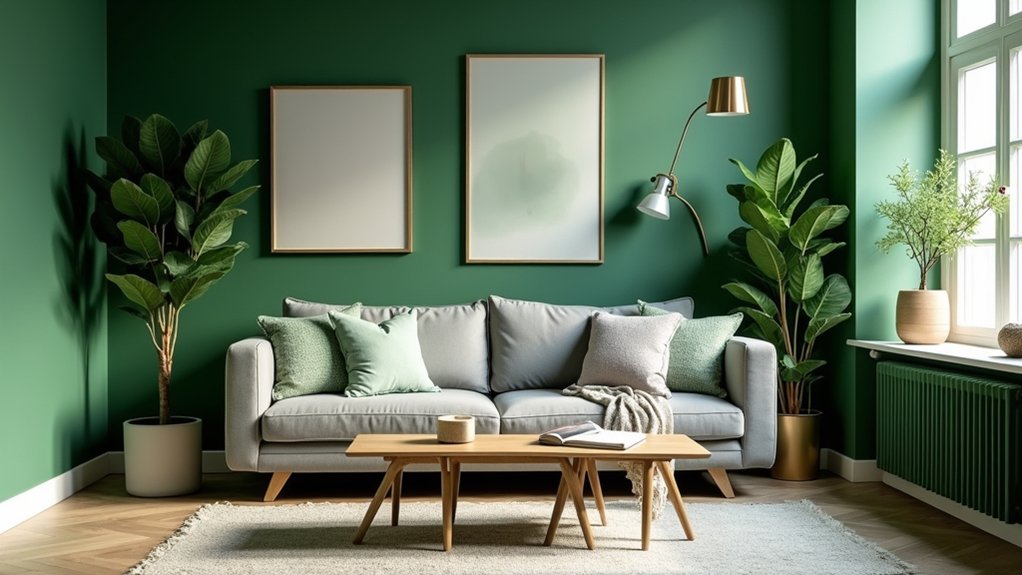
14 Green Living Room With Grey Sofa Ideas That Feel Balanced and Modern
Fourteen green living room with grey sofa ideas harness principles of color theory and spatial balance. Pastel greens, sage palettes, and deep forest hues provide chromatic bridges, optimizing both light diffusion and visual cohesion. Textural layering with velvet, wood, or rattan grounds neutrality, while green accents in cushions, rugs, and prints amplify depth and rhythmic movement. Strategic placement of architectural wood details and curated houseplants reinforces biophilic design. Further techniques reveal how these elements integrate for harmonious, modern environments.
Key Takeaways
- Pair sage green walls or accents with a grey sofa for a calming, biophilic atmosphere that feels fresh and modern.
- Mix green patterned cushions and throws on the grey sofa to add visual interest and create a cohesive, layered look.
- Use green colour drenching on walls and ceilings, grounding with wooden elements and a neutral grey sofa for a unified, contemporary space.
- Introduce leafy houseplants near the sofa to enhance air quality and add organic texture, seamlessly blending green tones throughout the room.
- Add a green patterned or solid rug under the grey sofa to define the seating area and create a balanced, inviting foundation.
Decorate With Light Green Pastel Tones
Light green pastel tones function as a versatile chromatic bridge between cool and warm neutrals, particularly when integrated with a grey sofa in the living room. These hues, grounded in color theory, counterbalance the inherent neutrality of grey by introducing subtle vibrancy while maintaining a calming atmosphere.
Spatially, light green pastel tones on walls or large-scale decor elements foster visual cohesion and expand perceived space, softening architectural lines and reducing stark contrasts. Their compatibility with beige and white further supports a harmonious palette, enhancing ambient tranquility.
Strategically placed accents—such as cushions, throws, or curated artwork—introduce depth and layered dimension without dominating the visual field. The resultant scheme not only supports restorative mood dynamics but also sustains a serene, inviting environment ideal for modern living spaces. Consider using lighting fixtures with metallic accents to enhance the overall aesthetic while maintaining the modern balance.
Pair Green Walls With Wooden Accents
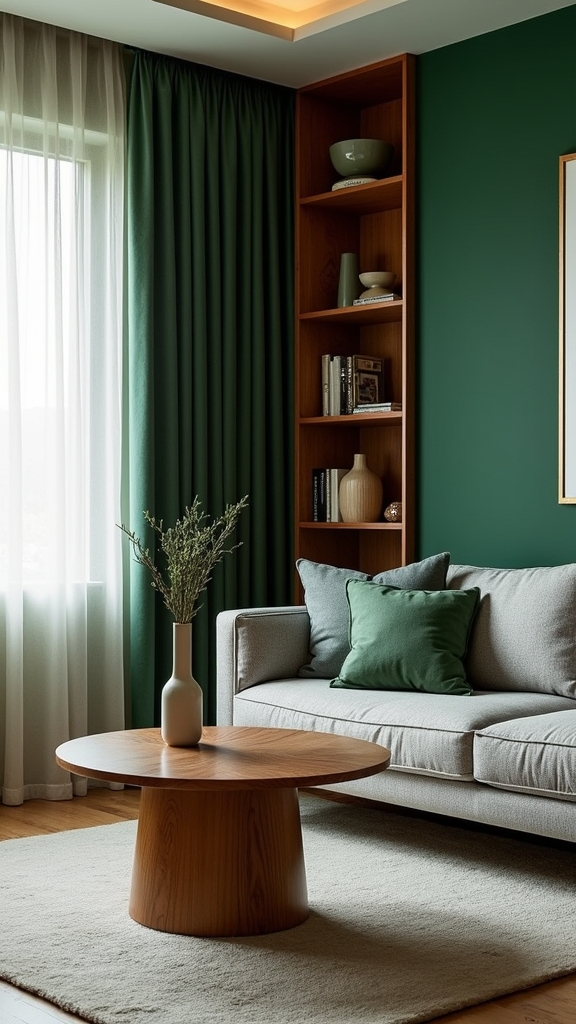
Integrating natural wood furniture within a green-walled living room introduces organic textures that visually ground the space and establish a biophilic connection.
Architectural wood details, such as exposed beams or trim, provide structural rhythm while enhancing the chromatic harmony between green and wood tones.
Employing a variety of wood finishes and grains guarantees tactile balance, preventing monotony and strengthening the interplay between color and materiality.
Showcase Natural Wood Furniture
Natural wood furniture introduces organic texture and visual warmth to a living room with green walls, achieving a balanced interplay between cool and warm color temperatures. The juxtaposition of green tones and wooden furniture utilizes principles of color theory, where the coolness of green complements the innate warmth of timber. Placement strategies should consider spatial awareness, using coffee tables or shelving to anchor sightlines and promote functional flow. Light wood species such as oak or pine amplify natural light, enhancing pastel greens, while walnut or mahogany contribute depth to saturated hues. This eco-conscious approach not only enhances aesthetic cohesion but also aligns with sustainable design trends.
| Green Tone | Wood Species | Effect Under Natural Light |
|---|---|---|
| Pastel Green | Oak/Pine | Airy, expansive, bright |
| Sage | Maple | Soft, tranquil, balanced |
| Emerald | Walnut | Dramatic, grounded, rich |
| Olive | Teak | Earthy, sophisticated, warm |
| Mint | Birch | Crisp, modern, luminous |
Highlight Architectural Wood Details
Beyond standalone wood furniture, architectural wood details such as exposed beams, window casings, and trim introduce structural rhythm and enhance the interplay between green walls and wooden accents.
In modern green living room ideas, these fixed elements underscore a nature-inspired aesthetic by visually anchoring the space and intensifying the organic palette.
Strategic use of architectural woodwork achieves both depth and warmth, especially when juxtaposed with green tones. The chromatic harmony between wood and green amplifies a sense of serenity while maintaining spatial cohesion.
- Exposed ceiling beams in light oak draw the eye upward, highlighting verticality against deep green walls.
- Wide wooden window casings frame outdoor views, reinforcing a seamless connection between interior and nature.
- Rich walnut baseboards delineate the perimeter, providing a grounded finish that unifies the overall design.
Balance Green With Texture
Texture acts as a critical mediator when pairing green walls with wooden accents, establishing both visual and tactile equilibrium within the living room. The interplay of green tones with natural wood introduces a harmonious balance rooted in color theory, as the coolness of green is counteracted by the inherent warmth of wood.
Spatially, incorporating wooden architectural features—such as beams or flooring—grounds the room and visually anchors green surfaces. Layering additional texture through elements like rattan armchairs or jute rugs enhances the organic palette, fostering a biophilic environment.
Wooden accents, when strategically distributed, prevent monotony and create depth, while the variation in surface finishes encourages a multidimensional sensory experience. The resulting composition feels contemporary yet grounded, supporting mood and well-being through cohesive, nature-inspired design.
Relax With Sage Green Palettes
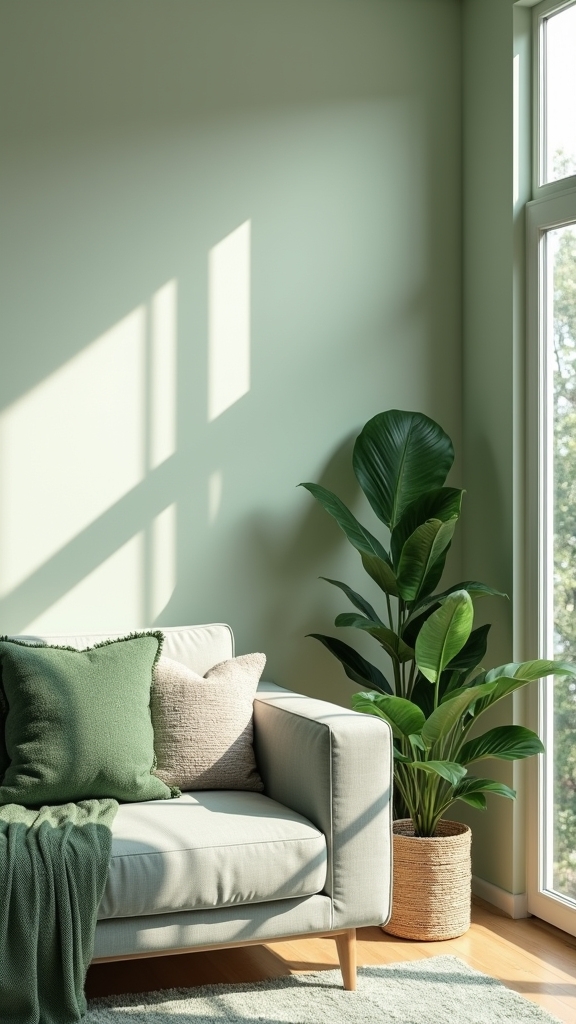
Sage green functions as a muted neutral, establishing a serene chromatic foundation alongside grey seating. The interplay of tactile materials such as velvet and boucle amplifies visual and sensory warmth, offsetting the cool undertones of the palette. Integrating botanical hues with wooden elements and organic decor reinforces biophilic design and spatial harmony. Incorporating natural materials like wood and stone enhances the cozy ambiance and elevates the aesthetic of the living room.
Sage Green as Neutral
A muted palette anchored by sage green introduces a nuanced neutrality that harmonizes with the cool undertones of a grey sofa. Within a modern living space, this chromatic pairing leverages color theory by using sage green as a desaturated, versatile neutral that balances visual temperature.
The spatial relationship between these tones establishes equilibrium, offering a restful yet sophisticated ambiance. Consider the following spatial applications:
- Sage green feature walls create a continuous backdrop, emphasizing the sleek silhouette of a grey sofa.
- Decor accents in sage green—such as vases, planters, or artwork—disperse this hue throughout the room, enhancing cohesion.
- Integration of natural materials, like wood or rattan, alongside sage green reinforces biophilic design principles, amplifying tranquility and inviting organic warmth into the modern living space.
Cozy Textures for Warmth
While sage green provides a serene chromatic foundation alongside a grey sofa, the introduction of tactile elements fundamentally enhances environmental warmth.
In a sage green living room, the use of cozy textures such as velvet and boucle enriches the spatial experience, offering both visual depth and physical comfort.
Soft furnishings—cushions, throws, and blankets—layered in varying green hues establish a nuanced interplay between cool undertones and warm tactile sensations.
Strategic placement of these textiles on or around the grey sofa amplifies the perception of intimacy and relaxation.
The juxtaposition of matte and plush surfaces, paired with the tranquil psychology of sage, results in a harmonious balance.
Such technical integration of color theory and texture raises the living area into a cohesive, inviting retreat.
Natural Accents and Decor
Numerous natural accents and decor elements, when integrated with sage green palettes, establish a visually balanced and restorative environment around a grey sofa.
The nuanced interplay between sage green—a sophisticated neutral—and organic textures cultivates spatial equilibrium. Utilizing natural materials introduces tactile diversity and reinforces an earthy, biophilic aesthetic.
Strategic color placement and botanical prints further amplify the calming effect, while also drawing the eye and delineating zones within the living room.
- Wood and Rattan Elements: Incorporate coffee tables or side chairs in natural materials to provide contrast and visual grounding against the cool tones of the grey sofa and sage green accents.
- Botanical Prints: Display framed foliage artworks or cushions with leaf motifs to infuse the space with organic rhythm and subtle color harmony.
- Layered Sage Green Textiles: Position throws and pillows to add warmth, cohesion, and a sense of tranquil enclosure.
Opt for a Dark and Moody Green Scheme
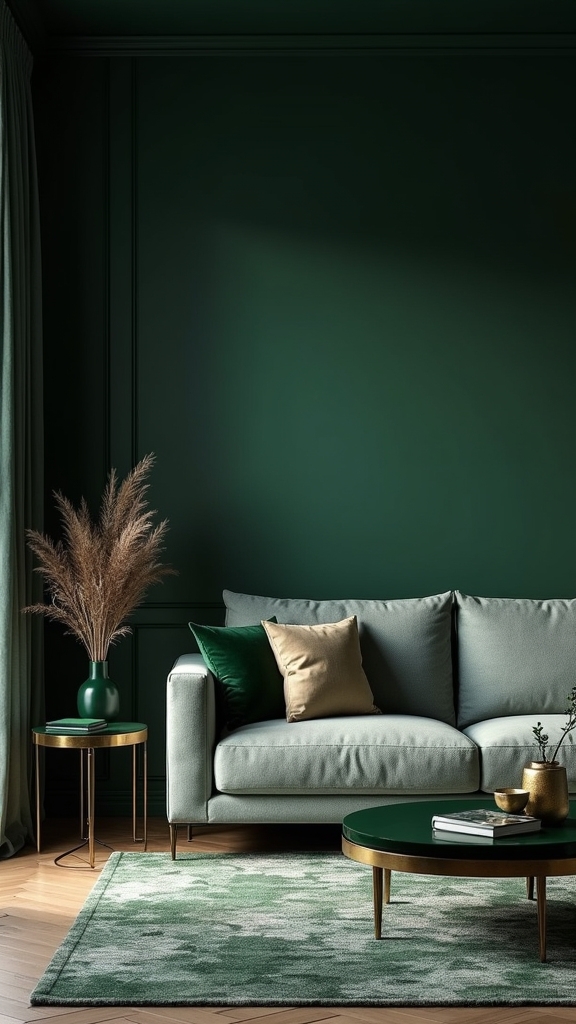
When paired with a grey sofa, a dark and moody green palette—such as olive or forest green—establishes a visually grounded environment that enhances spatial intimacy. The application of dark greens on walls or select furnishings introduces depth, while the grey sofa provides a neutral anchor within the chromatic scheme. To prevent visual heaviness, complementary colours—such as muted creams or blush tones—can be implemented through decorative elements like cushions or wall art, subtly raising the overall luminosity. Spatial balance is further achieved by maximizing natural and artificial lighting; mirrors may be positioned to reflect and diffuse light, counteracting the density of dark hues. Employing layering textures, such as matte wall finishes and wood accents, boosts the interplay of tactile and visual contrast, supporting a sophisticated, modern aesthetic.
Layer Cozy Textures for Depth
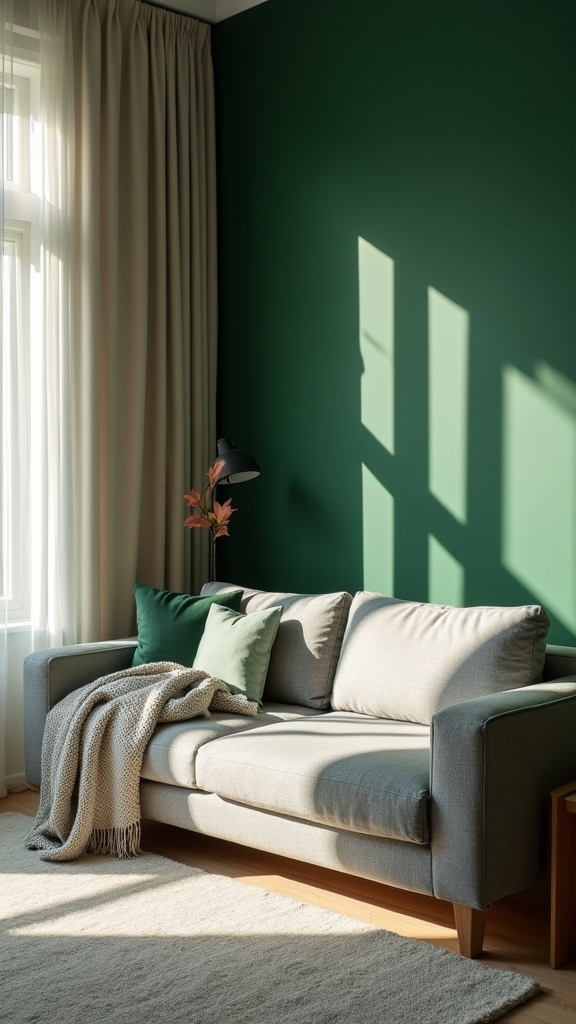
Beyond chromatic choices and lighting strategies, the integration of layered textures intensifies spatial richness within a green living room anchored by a grey sofa.
The interplay of tactile elements not only enhances comfort but also amplifies visual depth, ensuring the decor feels balanced and modern. Technically, layering cozy textures in green living room decor leverages both color theory and spatial awareness to counteract the inherent coolness and sleekness of a grey sofa. The strategic use of contrasting textiles like silk and chunky knits adds dynamic contrast, enriching the living room’s aesthetic harmony.
Layering tactile textures balances comfort and depth, transforming a cool grey sofa into a welcoming centerpiece in a modern green living room.
- Plush velvet pillows and chunky knit throws: These elements draped over the grey sofa introduce softness and tactile contrast.
- Natural fiber rugs in jute or rattan: Positioned underfoot, they ground the space and create a warm base layer.
- Textiles in various green shades: Curtains and cushions in mixed green tones provide subtle depth, enriching the overall palette.
Create a Focal Point With Botanical Wallpaper
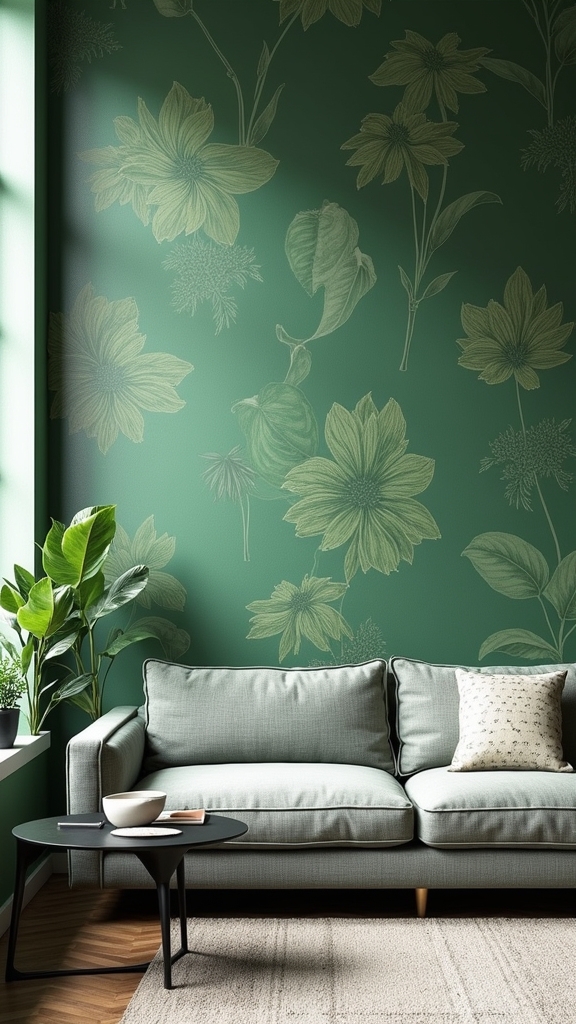
While establishing visual hierarchy within a green living room, botanical wallpaper functions as a strategic focal point, utilizing pattern and hue to direct spatial flow.
Selecting a bold botanical print for a feature wall behind a grey sofa enhances the green living room decor by synthesizing the natural palette with striking visual interest. The interplay of organic motifs and saturated greens creates depth, drawing the eye and anchoring the seating area.
For a more understated effect, simple motifs allow the wallpaper to recede while still reinforcing the room’s verdant theme.
Integrating wooden textures—such as furniture or accent pieces—alongside the botanical wallpaper bridges indoor and outdoor sensibilities, fostering cohesion.
Harmonizing wallpaper hues with existing furnishings guarantees the feature wall remains balanced and modern within the spatial composition.
Incorporating eco-friendly accents like recycled or upcycled decor not only adds a creative touch but also supports a sustainable living model, minimizing environmental impact.
Embrace Boho Decor With Earthy Greens
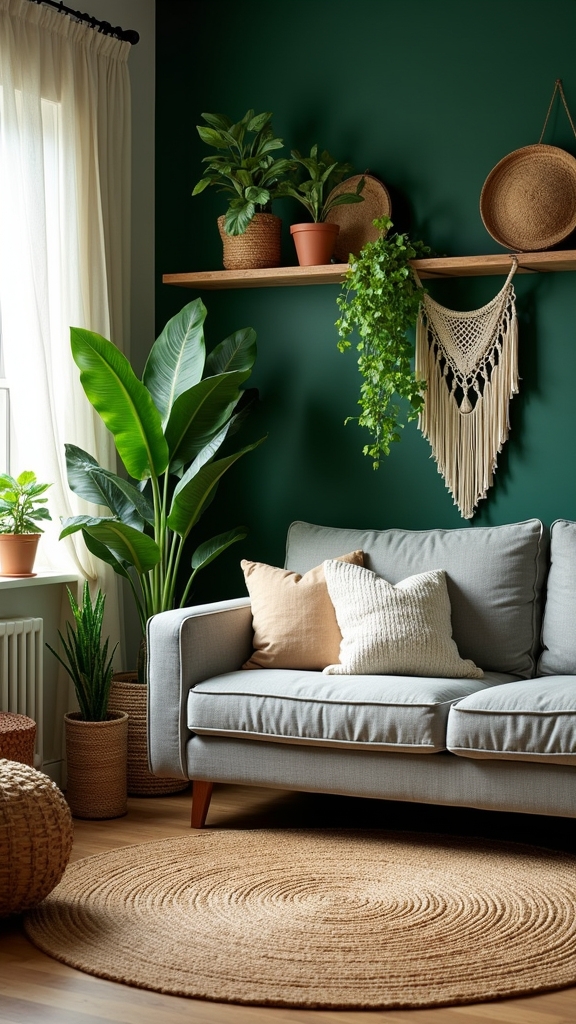
By applying color theory, designers utilize green hues to cultivate harmony between the neutral grey sofa and the organic palette of Boho decor. Earthy greens, ranging from sage to deep forest, introduce visual depth and a sense of tranquility, while spatial layering with textures and patterns enhances the relaxed ambiance.
Earthy green hues bring harmony and depth to a grey sofa, infusing Boho spaces with tranquil, organic energy and layered texture.
The interplay of natural materials and chromatic balance is essential to the Bohemian aesthetic. Incorporating eclectic furniture selection can further personalize the space, adding character and uniqueness through vintage finds and statement pieces. Woven cotton throws and pillows in diverse green hues, layered over a grey sofa, establish tactile and chromatic interest. Eclectic rugs featuring botanical motifs create visual continuity with the surrounding greenery. Wooden furniture and lush houseplants reinforce a grounded, nature-connected environment integral to Boho decor.
Try Colour Drenching for a Bold Statement

Colour drenching employs a single green hue across all planes—walls, skirting boards, and mouldings—to establish spatial continuity and intensity. By matching decor and accessories to this dominant shade, the environment achieves chromatic unity, allowing the grey sofa to function as a visual anchor. This approach leverages color theory to manipulate perception, amplifying room dimensions and emphasizing the interplay between saturated green and neutral grey. To further enhance the design, layering textures such as linen, silk, and faux fur can add depth and comfort, enriching the overall aesthetic.
Paint Everything in Green
By enveloping walls, skirting boards, and ceilings in a singular green hue, the technique of colour drenching establishes a visually unified envelope that enhances spatial perception and depth.
This method in green living room ideas leverages the immersive qualities of green paint, creating a seamless monochromatic field that expands the perceived volume of the room.
For ideal impact, a rich or saturated green is recommended, especially in spaces with ample natural light, to prevent the ambiance from feeling oppressive.
The interplay of green paint with a grey sofa introduces contrast and visual equilibrium, allowing the boldness of the walls to harmonize with the furniture.
- Verdant walls, ceiling, and trim blur architectural boundaries.
- A plush grey sofa anchors the chromatic intensity.
- Layered green textures—velvet, linen, and matte paint—add dimensionality.
Match Decor and Accessories
Extending the principles of colour drenching beyond architectural surfaces, a unified approach to decor and accessories intensifies the room’s chromatic logic.
By carefully matching decor and accessories within the chosen green and grey living colour palette, cohesion is achieved without visual monotony.
Employing various shades and textures of green—through cushions, throws, and patterned artwork—builds dimensionality and prevents flatness.
The grey sofa acts as a neutral anchor, its muted tone accentuated by the surrounding verdant hues.
Strategic placement of green accessories guarantees spatial balance, guiding the eye across the room.
Textural contrast, such as velvet cushions or woven throws, enhances tactile interest while reinforcing the dominant colour.
This holistic matching of decor and accessories embodies a bold, sophisticated statement, epitomizing contemporary green and grey living.
Bring the Outdoors in With Houseplants
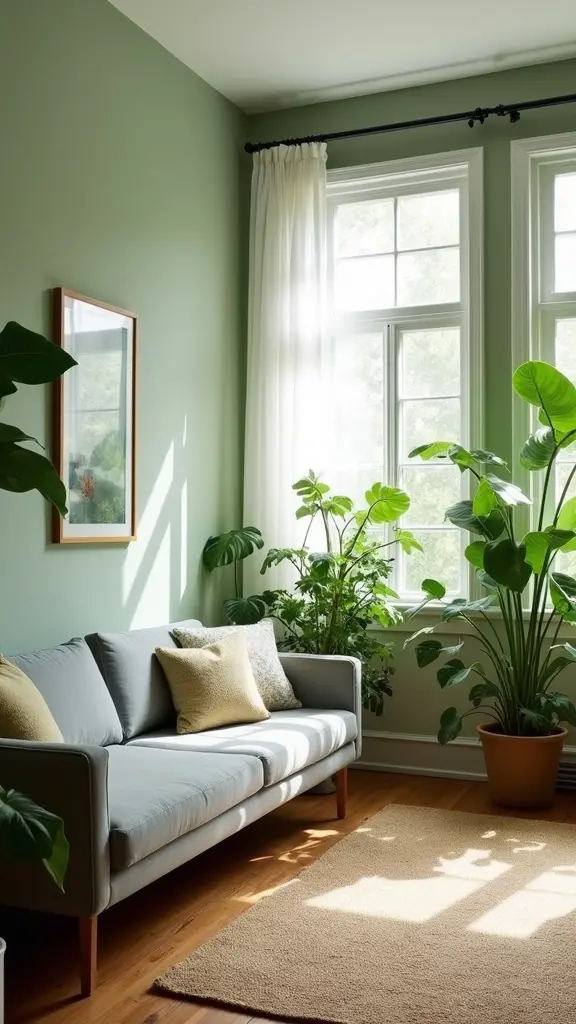
When integrating houseplants into a green living room with a grey sofa, careful spatial arrangement maximizes both aesthetic and functional benefits. The interplay between botanical textures and the neutral backdrop of a grey sofa enhances the ambiance, while utilizing color theory by layering varied shades of green. An indoor garden not only serves as a biophilic focal point but also improves air quality. Placement strategies should prioritize proximity to natural or artificial light, ensuring ideal plant health.
- Cluster ferns, pothos, and snake plants of varying heights adjacent to the sofa, using contrasting planters to highlight different shades of green.
- Establish a vertical indoor garden on a well-lit wall, creating a living tapestry that draws the eye upward.
- Rotate seasonal plant varieties to sustain visual interest and dynamic composition.
Plants like Monstera Deliciosa and Pothos are low-maintenance options that enhance air quality and regulate humidity, making them excellent choices for a living room setting.
Perk up a Work-From-Home Corner With Green
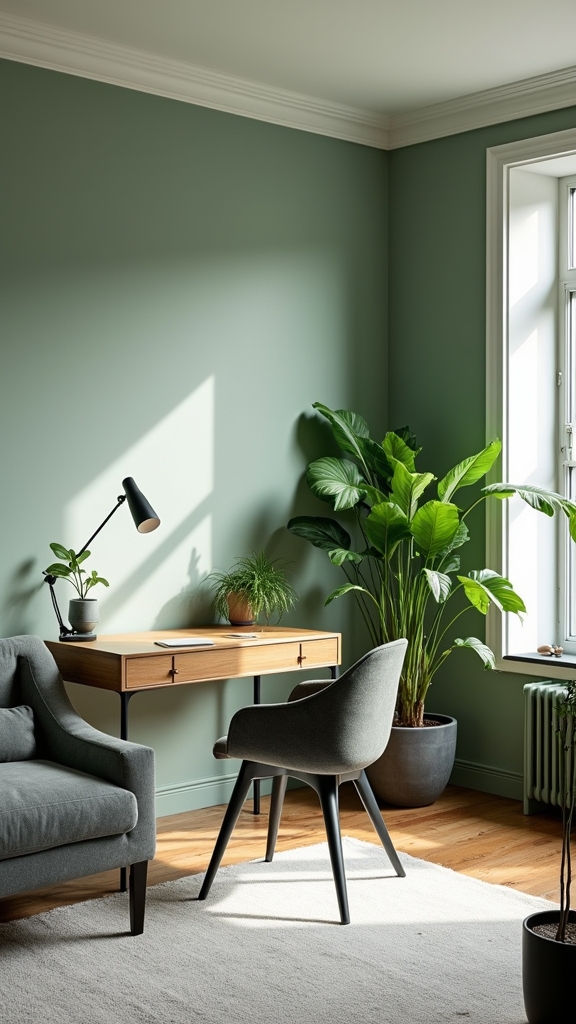
Integrating green tones into a work-from-home zone adjacent to a grey sofa introduces a chromatic stimulus linked to heightened productivity and cognitive flexibility. Strategic placement of houseplants and green-accented accessories leverages biophilic design principles, optimizing both environmental quality and visual intrigue. The interplay between green hues and natural light fosters an atmosphere conducive to sustained focus and creative ideation. Incorporating essential plants in your living room decor can enhance air quality, improve mood, and add vibrant natural beauty to your space.
Boost Productivity With Green
Although often overlooked, the strategic application of green hues within a work-from-home corner leverages color psychology to enhance cognitive performance and spatial ambiance.
Green, positioned on the color wheel between cool and warm tones, is associated with increased productivity and calming energy. Scientific consensus highlights that specific shades—such as deep forest green—can invigorate a workspace, while lighter tones like sage establish a stress-reducing, calming backdrop.
Integration of green with ideal lighting and ergonomic design elements further enhances this effect.
- Deep forest green accent walls energize productivity zones, creating a defined work area adjacent to a grey sofa.
- Sage green textiles—cushions, throws, or area rugs—soften spatial shifts, promoting a calming environment.
- Strategically-placed indoor plants and green decor personalize the workspace, increasing motivational cues and focus.
Inspire Creativity Through Color
By utilizing the inherent psychological effects of green, a work-from-home corner adjacent to a grey sofa can be transformed into a locus of creative stimulation.
Colour psychology suggests that green in a living environment fosters both optimism and enhanced problem-solving, making it an ideal choice for areas demanding creative output.
Applying green tones—such as soft sage or deep forest—either through wall finishes or accent décor, establishes a light and airy spatial perception while visually demarcating the workspace.
Integrating green artwork or desk accessories invigorates the zone without overwhelming the neutral foundation provided by the grey sofa.
Strategic placement of natural materials, such as wood or rattan, further harmonizes the palette, ensuring the workspace feels cohesive, inspiring, and conducive to imaginative thinking within a balanced modern context.
Enhance Focus With Plants
While the interplay of green hues and natural forms can subtly influence cognitive performance, the deliberate introduction of live plants in proximity to a grey sofa establishes a spatial zone optimized for focus and productivity.
Within a work-from-home corner, strategic plant placement leverages biophilic design by integrating elements that enhance focus and boost mood. Utilizing a neutral grey sofa as a backdrop allows the chromatic vibrancy of plants to visually punctuate the area, supporting attentiveness through color contrast and organic texture.
Consider the following spatial strategies:
- Position low-maintenance plants, such as snake plants, adjacent to the sofa to delineate the work zone.
- Vary plant heights and leaf morphologies to create rhythmic vertical movement and visual stimulation.
- Align planters near windows, maximizing daylight exposure and promoting an energizing atmosphere.
Accentuate With Green Cushions and Throws
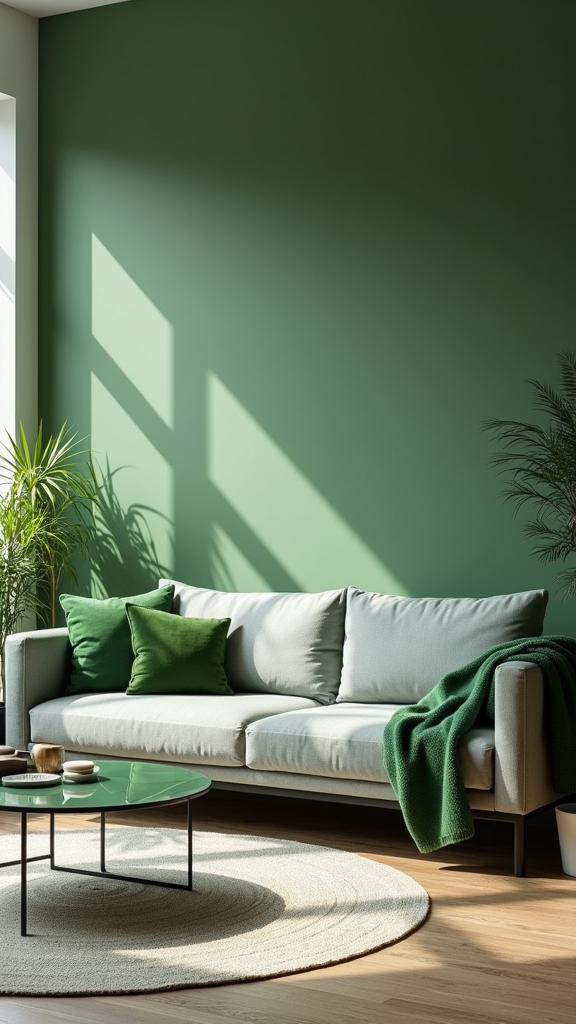
To achieve a dynamic interplay between cool and warm undertones, introducing green cushions and throws to a grey sofa leverages complementary color theory for visual impact.
The juxtaposition of vibrant green against the neutral grey sofa establishes a balanced chromatic relationship, enhancing spatial depth within the living room.
Selecting green cushions in varied hues, such as sage, emerald, or pastel, introduces a layered, modern aesthetic while maintaining equilibrium in the overall palette.
Incorporating mixed textures—velvet and linen—adds tactile contrast, optimizing both comfort and visual intrigue.
Patterned options, such as botanical or geometric motifs, infuse the arrangement with sophistication without overwhelming the harmonious tone.
Strategically draping green throws further integrates accent color, unifying the decor and reinforcing a cohesive, balanced ambiance.
Incorporating natural textures like wood and rattan can complement the green accents, adding warmth and depth to the living room environment.
Combine Light and Dark Greens for Contrast
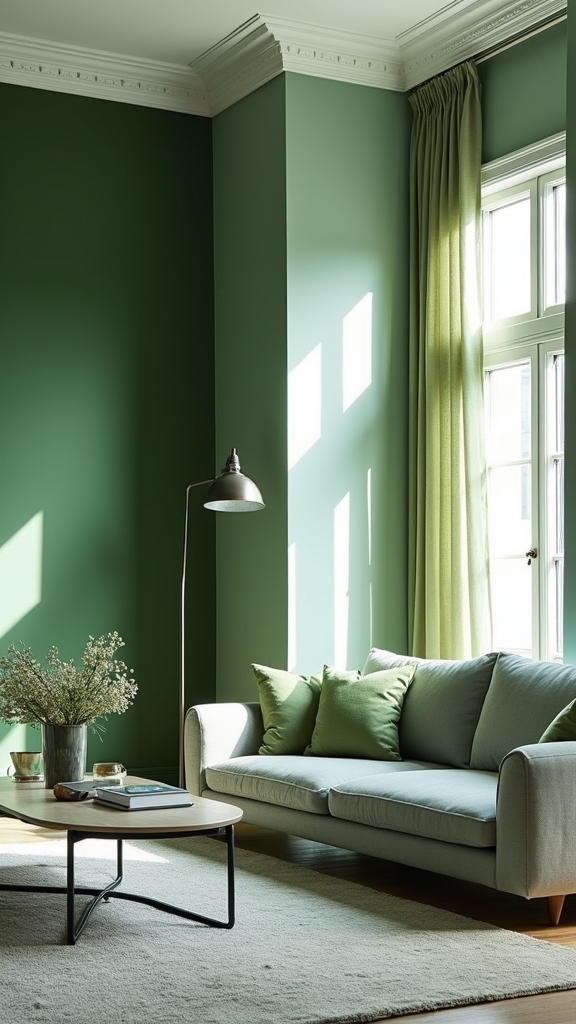
Although the integration of both light and dark green tones introduces chromatic complexity, this deliberate contrast cultivates spatial depth and visual hierarchy within a living room anchored by a grey sofa.
Light greens, when applied to expansive surfaces such as walls or large-scale furnishings, establish a luminous foundation that enhances perceived openness. In juxtaposition, darker greens function as focal accents—manifesting through cushions, artwork, or secondary textiles—to delineate zones without visual clutter.
The interplay of these hues is amplified by the introduction of natural materials, fostering a cohesive, biophilic ambiance.
- Light greens envelop the space, reflecting ambient light and expanding visual boundaries.
- Darker greens punctuate the environment, strategically drawing attention to architectural or decorative features.
- Natural materials—wood, rattan, linen—harmonize the palette, grounding the chromatic interplay.
Go Minimalist With Select Green Accents
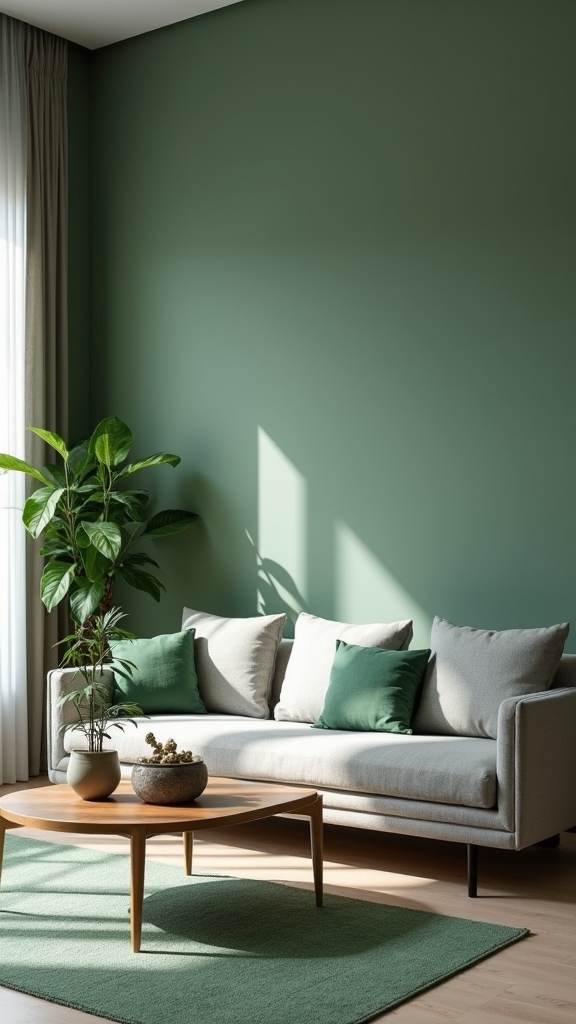
By limiting the palette to a single, carefully chosen green—such as sage or pastel—the minimalist living room achieves chromatic restraint that complements the neutrality of a grey sofa.
Minimalist design prioritizes spatial clarity and visual order, so green accents must be intentional and sparingly distributed.
Strategic placement of green accessories, such as a cushion, throw blanket, or a woven rug, creates a focal point without disrupting the room’s serenity.
The interaction between green accents and grey tones relies on a balanced chromatic relationship, where the subdued vibrancy of green provides subtle contrast while maintaining harmony.
Natural elements, like potted plants, introduce organic texture that softens the strict lines of minimalist design.
The result is a sophisticated, tranquil atmosphere defined by cohesive simplicity and spatial equilibrium.
Experiment With Green Patterns and Prints
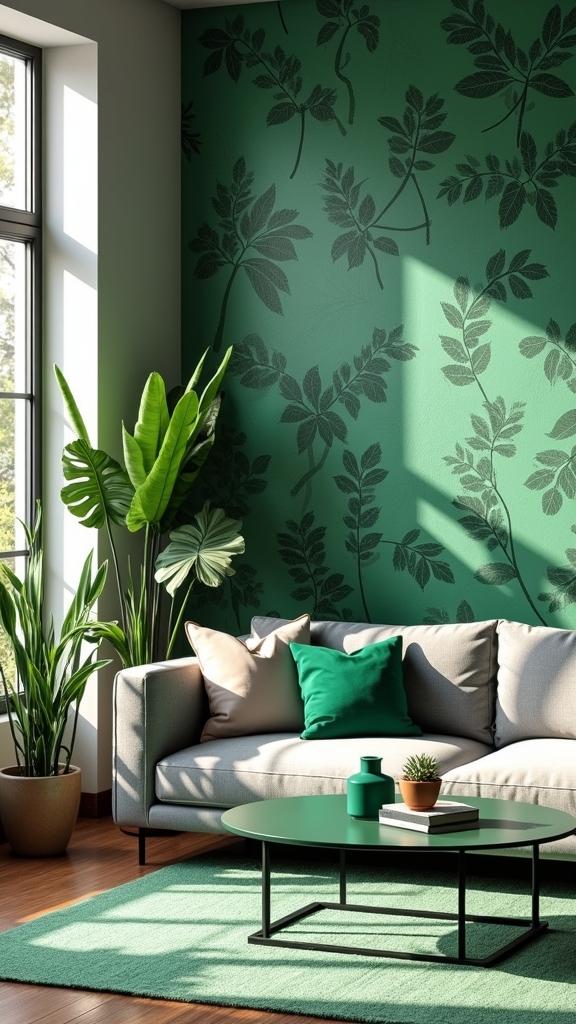
When green patterns and prints are introduced into a living room with a grey sofa, the spatial dynamic shifts through calculated use of color contrast and texture. The neutrality of the grey sofa acts as a chromatic anchor, allowing green patterns to emerge as focal points without overwhelming the environment.
Green patterns enliven a living room, with a grey sofa providing the perfect neutral anchor for striking color and texture contrast.
By utilizing the principles of color theory, designers can optimize visual interest and spatial harmony.
- Patterned green rugs beneath the grey sofa ground the seating area, layering geometric or botanical motifs for depth.
- Green printed curtains frame windows, enhancing verticality and introducing a controlled play of light and shadow.
- Mixing striped or floral green cushions with solid textiles on the grey sofa produces rhythm and visual movement, maintaining modern balance.
Strategic placement allows for effortless seasonal or trend-driven updates.
Frequently Asked Questions
Does Green Go With a Grey Sofa?
Green accents are compatible with a grey sofa due to their complementary undertones, achieving texture balance and spatial harmony. Utilizing nature-inspired hues, green introduces chromatic contrast and visual interest, aligning with principles of color theory and interior spatial dynamics.
Do Gray and Green Go Together in a Living Room?
Gray and green demonstrate strong compatibility in living room design through color theory, where gray accent colors provide neutrality, allowing green wall art to serve as a focal point. This pairing supports modern decor styles by balancing spatial harmony and visual interest.
What Shade of Green Goes With Grey?
Selecting a shade of green to pair with grey involves color theory principles; forest green offers rich contrast, sage green introduces subtle harmony, and olive green provides warmth. Spatial composition benefits from layering these tones for visual depth and cohesion.
What Color Couch Goes With a Green Room?
Selecting a couch fabric in neutral tones—such as grey, beige, or tan—ensures visual harmony in a green room. Integrating accent colors and room accessories in complementary hues enhances depth, spatial cohesion, and balanced color dynamics.
Conclusion
A harmonious green living room anchored by a grey sofa benefits from nuanced application of color theory and spatial dynamics. Strategic use of tonal variation—ranging from pastel to moody greens—creates depth, while layering textures and wooden accents enhances visual warmth. Integrating patterns, prints, and select green accessories optimizes focal points without overwhelming the space. Minimalist or maximalist, these approaches leverage contrast and balance, ensuring a modern aesthetic where the interplay of green hues and grey remains spatially coherent.
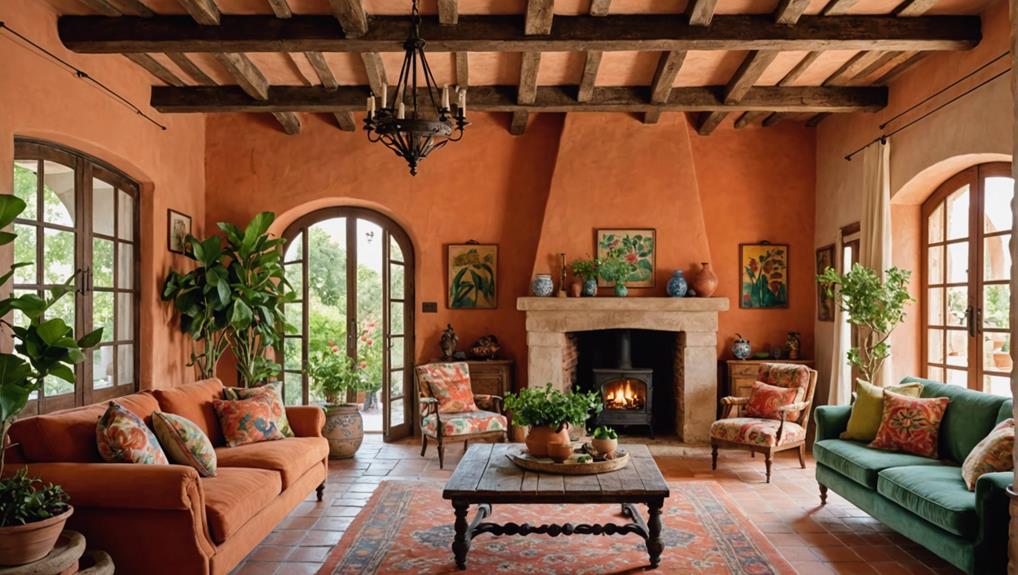
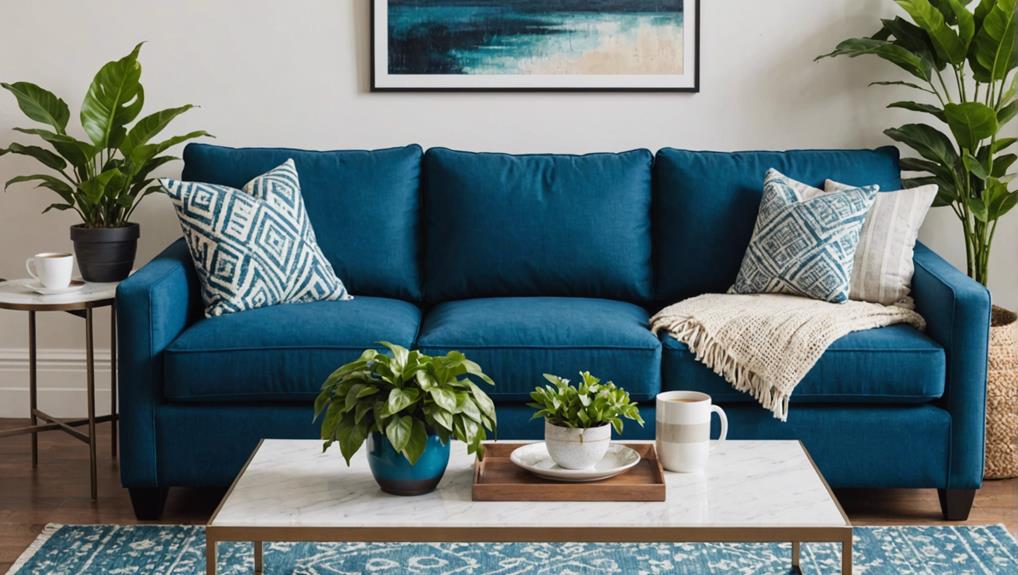
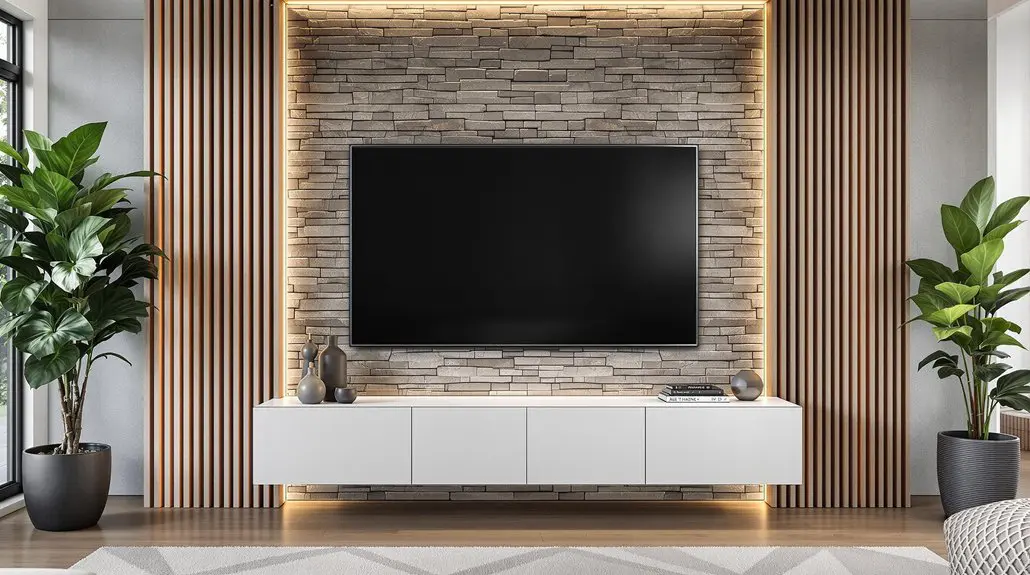
Leave a Reply